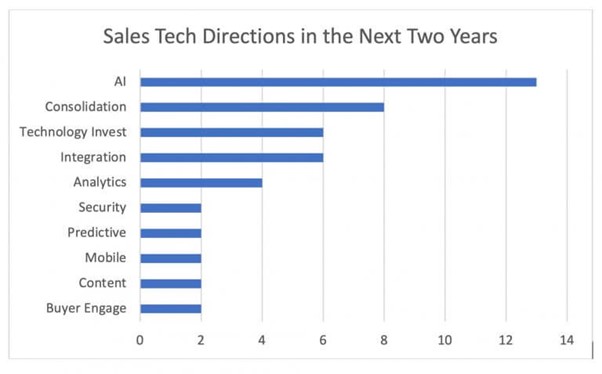Sales tech has seen quite a few years of sustained growth, with investment rising dramatically. In fact, it grew from US$1.8B in 2020 to over US$4.3B in 2021, with over $3.7B of that going to late-stage funding rounds. But now, in 2022, what does the future hold?

Well, we're not giving salespeople laser eyes and jetpacks anytime soon. Although, I'm sure those networking events would be far more fun.
However, are we seeing the end of the sales tech boom? And how can you adapt to this new landscape? Where should you invest, and where should you stay away? What even is going on? These questions, and more. answered.
But what hasn't changed is the need for a robust tech stack. It is essential to the running of a modern and efficient revenue-generating company. But the trick, in a tumultuous landscape, is to prioritise investment in specific technologies. Especially now the vendor market is moving from a wide set of categories to a narrow list of vendors with wide portfolios of capabilities.

But let's have a look at the biggest, newest, sparkliest developments in SalesTech, and what they mean for the future of the industry.
Number One: The List of Sales Unicorns is Growing
First up: what is a unicorn? No, it doesn't mean that the company is covered in glitter and rainbows. It simply refers to any startup that reaches a valuation of $1B. Currently, we've seen DRM providers riding the wave. This looks like Salesforce buying sales enablement vendor LevelJump, with sales enablement seeing four more unicorns.
There's also been a boom in sales tech unicorns entering the space, with names such as Clari, Gong, Highspot, Pandadoc, and Drift making headlines. These unicorns are seeing relentless growth, and we will likely see more this year.
Number Two: We Will See Even More Personalisation
2022 will see even more personalisation of the buyer's experience - it's what they expect.
So, it is vital that 2022 sees more sales and marketing alignment, which is key for any successful business. Buyers always expect a tailored experience, right from the first interaction. This means to create this experience, custom sales assets and data of their previous interactions and ideals are essential.
Sellers also need to consider diversifying the sales channels. But, they must also keep the brand experience consistent. No easy task.
But it must be considered that by 2025, it is predicted that 80% of B2B sales interactions will be digitised. This means that sales reps must align their activities to the buyer's preferred engagement channels.
The journey to personalisation must follow a number of stages. It must involve tracking the preferences, running suitable campaigns, followed up by sharing sales assets and important reports to improve on the next campaign. Various sales tools can automate and improve the experience. Utilising them can also improve the sales workflow and result in higher sales revenue.
Number Three: Mergers and Acquisitions Increasing
Known as "Alpha Platforms", there are a group of hyper aggressive vendors who are broadening their capabilities at a rapid pace. They have, and will continue to, traverse the landscape and consume other companies. This tends not to be direct competitors, but adjacent categories, such as the following moves:
- 6Sense acquiring Fortella (third-party analytics) and Slintel (technographic data).
- ZoomInfo acquiring RingLead (data workflow).
- Outreach acquiring Canopy (intelligence) and Sameplan (mutual action plans).
- Clari acquiring DealPoint (mutual action plans).
Number Four: Remote and Hybrid Sales Workforce
More than 75% of buyers actually prefer virtual interactions. And what the buyers want, the buyers should get.
Self-serve options and customers' access to vital information mean that remote selling has managed to go at breakneck speed, whilst providing high levels of convenience. Lots of B2B businesses, such as logistics, pharma, and manufacturing, have adapted to a remote way of working.
However, sales managers have had a hard time monitoring their teams and keeping productivity high. But by introducing the use of sales tools such as CRMs and ERPs, managers can keep an eye on the most important performance metrics.
Management of sales workflows and leads has also been integrated into cloud platforms and mobile applications. This has improved and encouraged transparency within the teams and has developed a better remote working model. The innovation within management is helped by sales tech, with the manager's role evolving into somewhat of a sales coach instead.
Number Five: AI in SalesTech
AI is getting its fingers into every pie. Salestech is no exception.
Many vendors have some sort of AI in their solutions already, with natural language processing being the most common. However, many vendors look to AI to better recommend content and actions and even predict the next actions of buyers.
AI depends on a lot of data, which derives from analytics on deals and actions. So, the amount of data available to a user will vary.
including machine learning, computer vision, natural language processing, deep learning, and more.
All of these technologies help machines perform specific cognitive tasks in a similar way to humans, just with more power behind them.
But where do sales come in? Well, think automation on a bigger scale. These technologies analyse large data sets and use their advanced computational firepower to extract insights from this data.
These insights can then be used to make predictions and decisions.
Obtaining reliable customer data is vital for salespeople's success. But in this day and age, data is everywhere. And I mean everywhere. The daily amount of data uploaded every day is set to grow to 463 exabytes by 2025. That's too much for one human being to handle. So, the possession of billions of data points is basically useless for businesses without some way to sift through them.
So, that's where AI comes in. It can wade its way through all this data, organise it, and put it to use. This way vendors get to understand their customers, prospects, and market by looking at the (now neat and clean) data they generate. This can help with:
- Lead generation
- Pipeline monitoring
- Sales forecasting
- Real-time marketing
- Communication with customers
- Enhanced productivity
Speaking about enhanced productivity, AI can really help in its automation of tasks, removing mundane or tedious workloads from your team. This removes time restraints and room for human error. It'll also speed up communication inside your organisation, making it smoother.
So, how can you prepare your team for this big change?
- Foster a data-driven mindset. In order to create the space for AI, your business needs to rely on data, as well as their own expertise. Successful companies in this space embed data into their core business functions.
“My motto is ‘People don’t do what you expect, they do what you inspect,’” says Chester Liu, VP of Growth at Allego.
“Sales leaders can influence their teams to be data-driven in a number of ways. This includes being transparent about using your data to make decisions and making sure everyone on the team who needs access to data has it. Be strategic about which metrics you want to measure. These will rise to the forefront of your team’s attention." - Monitor and evaluate sales tech. In order to keep up with changes in the rapidly evolving market of sales tech, sales leaders must be up for the challenge. This means being aware of the space, which can be eventually facilitated by AI, which can automatically transcribe analysis to managers.
- Integrate your data. AI tools need access to multiple data sources to train the models and feed them real-time input for analysis. This data might be managed by your company, using CRM, conversations, content analytics, digital interactions, customer success and support systems etc. Then, information from third-party sources or business datasets can be fed into the AI.
- Train your team. Your team must be set up for success with training to fully leverage your AI's capabilities. Although most of the inner workings will be invisible to users, AI works best when a team is trained. They need to be trained on the consistent set of rules the AI will follow, i.e. how the reps should articulate the brand's core positioning, and messaging. By analysing calls, and applying these standards, the AI can give sellers suggestions for appropriate buyer content to follow up with, as well as personalised coaching, and remediation training.
Number Six: Sales and Marketing Unification
As we've mentioned before, all this requires a good deal of cooperation.
Martech and salestech have both matured as industries over the last few years. Sophisticated data management platforms and CDPs or related technologies provide for strong audience segmentation and instant campaign management and activation across multiple channels.
In the cookie-less future we're finding ourselves in, marketers and salespeople will have to work closely together to unify their data and centralise customer records. A more aligned sales and marketing approach can lead to:
- More than 200% revenue growth from marketing tactics.
- Organisations with aligned departments can achieve up to 38% higher sales win rates.
- Marketing and sales alignment leads to 36% higher customer retention.
- Aligned organisations save 30% on their customer acquisition cost. Plus, their customers have a 20% higher lifetime value.
- Gaining new customers can cost 5X as keeping existing ones.
- Companies with “tightly aligned” departments reach 24% faster revenue growth and 27% quicker profit growth for three years.
- Companies see an average of 19% faster revenue growth and 15% profitability when sales and marketing teams are aligned.
- Over 80% of sales and marketing executives describe each other’s departments positively
And specifically, a more aligned data approach and the process can lead to 36% higher customer retention rates, and it can make companies 67% better at closing deals.
Centralised records and processes which allow cross-team sharing of important insights and key analyses as well as CRM data and email marketing statistics will become a priority and will help both teams structure visitors and prospect preferences and interests.
When there's a more streamlined process in regards to sharing information between the two teams, salespeople will be equipped with the right information to track and lead customer conversations with relevance.
So, there might not be any jetpacks or laser guns, or even rocket ships on the sales tech horizon. But all this sounds pretty darn futuristic.
Not enough Sales Enablement for you? Check out our Sales Enablement & Sales Operations Best Practice Guide, here!
